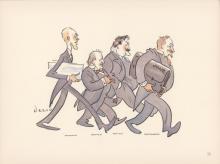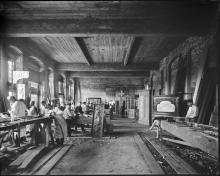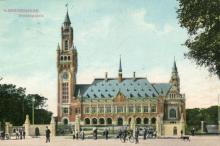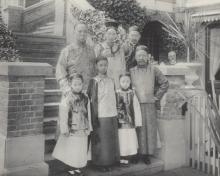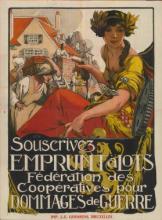The Library holds a unique collection of images including cartoons, designs, engravings, posters, maps and photographs. Together these images form a visual supplement to the book collection. They show important historical scenes, maps, objects or persons and refer to themes and subjects, reflecting the Collection Profile of the Library. A particularly fine example is given by the posters from both the First and the Second World War. They depict themes such as War, Peace and Anti-war movements, and give vivid impressions of the horrors of war, calling for support for the war effort and the fight against fascism.
The Library has divided its collection of images into various sub-collections. The complete overview of these collections can be found in our database, CONTENTdm.
Help us describe our collections
We aim to describe and identify our collection items as accurately and as comprehensively as possible. On some of them we have very detailed information, but on other items we have very little information. Your knowledge and information can help us! When and where were these items produced or printed, and by whom? Enjoy our digital collections and let us know what you think of it.
Highlights
Cartoons on the Peace Conference in Lausanne (1922–23)
For centuries, cartoonists have used their pens to fight war against war, translating images of violent conflict into symbols of protest. These images tell the story of many journalists and cartoonists around the world struggling to promote peace, justice, democracy and freedom of expression. Cartoons may amuse, provoke, stress truth or paradox in a few lines only.
In this collection, an interesting selection of 25 cartoons by Alois Derso and Emery Kelèn concerning the peace conference in Lausanne, Switzerland (1922-23). Its purpose was the negotiation of a treaty to replace the Treaty of Sèvres, which, under the new government of Mustafa Kemal Atatürk was no longer recognized by Turkey. The conference resulted in the Treaty of Lausanne signed on 24 July 1923.
The Derso and Kelèn collection consists of correspondence, writings, published materials, and over 900 cartoons and caricatures in varying media ranging from pencil sketches and ink drawings to richly-hued watercolors and limited edition lithographic portfolios.
Alois Derso (1888-1964) and Emery Kelèn (1896-1978) were two internationally famous caricaturists and political satirists, of Hungarian origin, who worked at the League of Nations for fifteen years. They drew caricatures of the League of Nations delegates and politicians, as well as significant events such as the Lausanne conference. The vast majority of the works were produced between 1920 and 1950, the active period of their collaboration.
Click Cartoons on the Peace Conference in Lausanne (1922-23) in CONTENTdm.
Engravings collection
From portraits of nobles to maps of distant islands, from scenes of everyday life to allegorical depictions of life and death. The Engravings collection offers a vivid visual journey through the 16th, 17th, and 18th centuries. These engravings, drawn from historical books in the Library’s holdings, capture the intellectual, cultural, and artistic landscapes of their time.
Each engraving is carefully described and contextualized, accompanied by information about the book in which it is found. This allows readers and researchers not only to understand what is depicted, but to grasp the deeper meanings behind the details. The collection is fully searchable by keyword, artist, or book title, making it a valuable tool for scholars, students, and anyone curious about the visual culture of early modern Europe.
You can explore how spaces and events were represented and imagined, how novels and treatises were illustrated, and how remarkably skilled the engravers were in their craft. Indeed, these engravings are historical sources but also works of art. Feel free to explore the past, through both knowledge and beauty.
Click Engravings collection in CONTENTdm.
"Het Vredespaleis, samengesteld door Ir. J.A.G. van der Steur"
A portfolio of 50 prints of architectural photographs was published a couple of years after the opening of the Peace Palace in 1913. This collection of black and white photographs of the exterior, garden and interior with the most important rooms including architectural details shows the building in all its grandeur. These photos were selected by the Dutch architect J.A.G. van der Steur (1865-1945).
For the design of the Peace Palace an international architecture competition was launched and the neo-renaissance design of the French architect Louis Marie Cordonnier (1854-1940) was selected as the prize winning design. The French architect was asked to adapt and simplify his original design because it was considered to exuberant and expensive. A final design was made in collaboration with the established Dutch architect Johan van der Steur, who was also appointed as executive architect for the construction of the palace.
A brochure is included in the portfolio with a description of the photographs and an extensive introduction written by the journalist and peace activist Henri van de Mandere (1883-1959) describing the history of the establishment of the Peace Palace.
Click "Het Vredespaleis, samengesteld door Ir. J.A.G. van der Steur" in CONTENTdm.
International Architecture Competition for the Design of the Peace Palace
The Peace Palace is a remarkable building. By Dutch standards it is a building of uncommon grandeur and a very recognizable sight in the city of The Hague. However, the Peace Palace might have been a completely different building. On 15 August 1905 the Program of the Competition for the Architectural Plan of the Peace Palace for the use of the Permanent Court of Arbitration with a Library was sent out all over the world. The competition was open to all. On the closing day, 15 April 1906, no less than 216 plans had been submitted, covering a total of more than 3.000 drawings.
This collection consists of a selection of the various designs and drawings from this competition, published in the book International Competition of the Carnegie Foundation: the Palace of Peace at The Hague: the 6 premiated and 40 other designs chosen by the Society of Architecture at Amsterdam and reproduced under its direction, Seventy-Six Plates, London; Edinburgh, T.C. & E.C. Jack, 1907.
Click "International Architecture Competition for the Design of the Peace Palace" in CONTENTdm.
Peace Palace postcards
As soon as the building process of the Peace Palace was finished in 1913 it instantly became one of the landmarks of The Hague. Over the past century numerous postcards depicting this building have been sent home to family and friends with “greetings from The Hague”. The Peace Palace is such an important and iconic building for the city that it is also one of the bestselling items on souvenirs and curiosa.
[Under construction.]
Photo Album Conférence de la Paix, La Haye 1899
The Library holds two albums with historical photographs of the First Hague Peace Conference of 1899. These two albums were a gift to Jonkheer J.C.N. van Eys, secretary-general of the Conference and to Dutch foreign minister and honorary chairman, Mr. W.H. de Beaufort. All key figures received a personalized photo album with red cover and letters in gold: Conference de la Paix, La Haye 1899. Wilhelmina, queen of host country The Netherlands, received a more luxurious version of the album with her portrait displayed at the front cover.
The high-quality photographs shown in the albums were taken by a Polish photographer Bolesław Matuszewski (1856-1943). Matuszewski was a photographer at the Imperial Court of Tsar Nicholas II from 1897 onwards. The assignment given to him must have been quite extensive as besides the many photos he took at the Conference he also portrayed most of the heads of states of the Nations represented at the Conference.
Click Photo Album Conférence de la Paix, La Haye 1899 in CONTENTdm.
Poster collection
The Poster collection reflects subjects such as “Peace”, “War” and “Anti-war movements”. The images on the posters from World War I and World War II, for example, give vivid impressions of the horrors of war, calling for support for the war parties and the fight against fascism. Recruitment, propaganda, rationing, support for wounded soldiers, fundraising - during the First World War posters were used to inform and rally the public as never before. The War, a new low in the annals of armed conflict, coincided with a golden age for the relatively new art of advertising. Striking and colourful posters were produced throughout the years 1914-18 to recruit soldiers, promote investment, keep up morale and, naturally, to vilify the enemy. Prominent artists paired bold images with punchy text to maximise impact.
The Library's Poster collection is fully available online. The variety of posters on display show us the different approaches used by the countries using the poster as an instrument of the propaganda machine. But it also is interesting just to look at the variety in designs. For example, Germany produced posters with bold imagery and a clear message and France had an obvious tradition of art posters clearly seen in their decorativeness. Millions of posters were produced during the War. Although the United States was involved in the War only by 1917, this country alone produced 2500 poster designs and approximately 20 million posters.
Click Poster collection in CONTENTdm.
